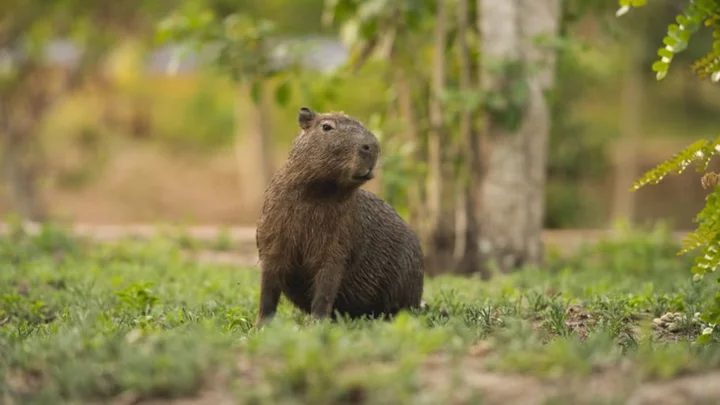The world’s largest rodent, the capybara, has delighted the internet for years. With a heavy, barrel-shaped body, short head, webbed feet and reddish-brown fur, they have a unique and memorable appearance. From Japan’s “Paradise of Capybara” zoo exhibit to their invasion of an Argentinian gated community, people can’t get enough of these “coconut doggies.”
To their credit, the capybaras haven’t let the attention go to their head. These wild animals are calm and remarkably social, enjoying time with their herd, other animals, and humans. The rodents even appreciate belly rubs.
The adorable animals are native to South America. So when people began spotting them in north-central Florida, there were some questions.
Why are there capybaras in Florida?
Like many things in Florida, the origin of their capybaras is a mystery. The United States Geographical Survey recorded the first sighting in 1990, and two years later another was reported to a University of Georgia invasive species project after it was struck by a car. But things seem to ramp up in the mid-’90s, when five capybaras escaped from the Lubee Foundation.
The organization—now known as the Lubee Bat Conservancy—hosted a wide variety of animals in their early years. The capybaras made a break for it when a 1994 hurricane destroyed the fence surrounding their enclosure. The semi-aquatic creatures prefer to live in the dense foliage that surrounds rivers, lakes, and marshes, all of which are readily available in the Sunshine State; the weather also resembles their South American homeland. So when the escapees found themselves in familiar territory, they immediately began to settle in. Alachua County continues to be the nucleus of Florida capybara sightings today.
Escaped capybaras aren’t unique to Florida. Their gregarious personalities and rub-able tummies make them a popular choice of exotic pet, resulting in bans in several U.S. states. In 2011, wardens from the California Department of Fish and Game confirmed that a capybara, likely an escaped pet, was swimming around the Salinas River. And in 2022, an Illinois hunter killed a capybara while bow fishing off the St. Mary’s River. Allegedly, it was quite tasty.
But unlike the runaway pets on solo journeys through America’s rivers, the Lubee Foundation escapees were ready to start a family. Capybaras breed incredibly quickly: They average four pups a litter but are capable of producing up to eight. They also happen to be great parents, with the entire herd taking on childcare duties. By the time the five escapees were recaptured in 1995, they had already reproduced. Between 1994 and 2003, 38 additional capybaras were removed from the area.
Are Florida’s capybaras invasive?
Today, the Florida Fish and Wildlife Conservation Commission considers capybaras an established species. Elizabeth Congdon, an associate professor at Bethune-Cookman University in Daytona Beach and the only North American biologist to specialize in capybaras, has investigated if the South American newcomers could be a threat to Florida’s environment. “I love them, and they're my favorite animal on the planet, but at the same time, it may be necessary to remove them from here,” she told ABC News in 2016.
According to some estimates, there could be as many as 50 capybaras living in Florida. They don’t appear to be outcompeting native species or causing harm to humans, which classifies them as an “exotic” species instead of “invasive.” But just because they’re harmless now doesn’t mean they’ll continue to be in the future.
In a worst-case scenario, capybaras turn out to be like their rodent cousins, the nutria. These South American semi-aquatic rodents were first imported for fur farming in the southern and western United States in 1899. When the industry collapsed in the 1940s, thousands of nutria were released into the wild. Unfortunately for America’s wetlands, the ravenous rodents thrived. Today, nutria devour crops, burrow through agricultural levees, and destroy coastal marshes. The state of Maryland spent 12 years and worked with hundreds of private landowners to remove the animal from its borders [PDF].
But the capybara situation likely isn’t that dire. Capybaras could potentially cause problems for humans in two ways. They could move into agricultural areas and snack on Florida’s economically important corn and sugarcane crops. They also serve as reservoirs for the Rickettsia rickettsia bacteria that causes Rocky Mountain spotted fever, which passes from animals to humans via ticks.
After 20-odd years living in Florida, the rodents seem to be here to stay. After all, the capybara craze isn’t just a source of fun social media content—it’s a great way to spread facts and raise awareness.
For those lucky enough to spot a wild capybara, the Florida Fish and Wildlife Conservation Commission advises against approaching it. Instead, snap a photo and report it to the local authorities—and perhaps post it online, too. It might go viral.
This article was originally published on www.mentalfloss.com as Florida is Home to the Internet’s Favorite Rodent.









